Printed Signage Market Size
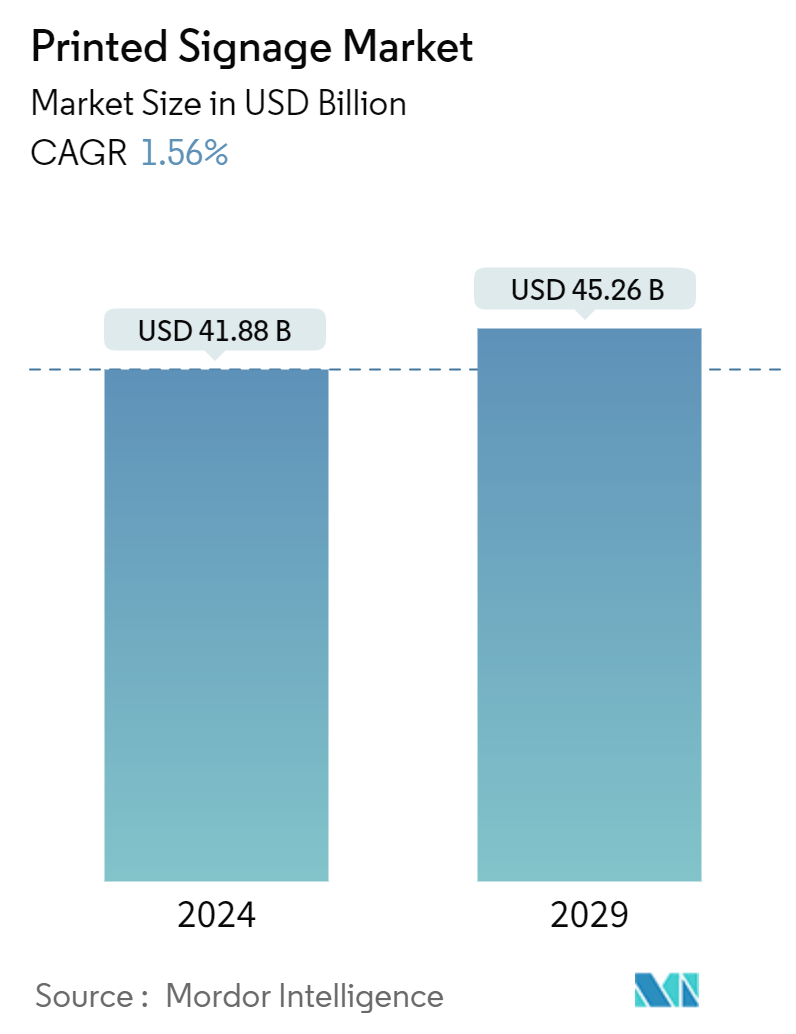
| Study Period | 2019 - 2029 |
| Market Size (2024) | USD 41.88 Billion |
| Market Size (2029) | USD 45.26 Billion |
| CAGR (2024 - 2029) | 1.56 % |
| Fastest Growing Market | Asia Pacific |
| Largest Market | Asia Pacific |
Major Players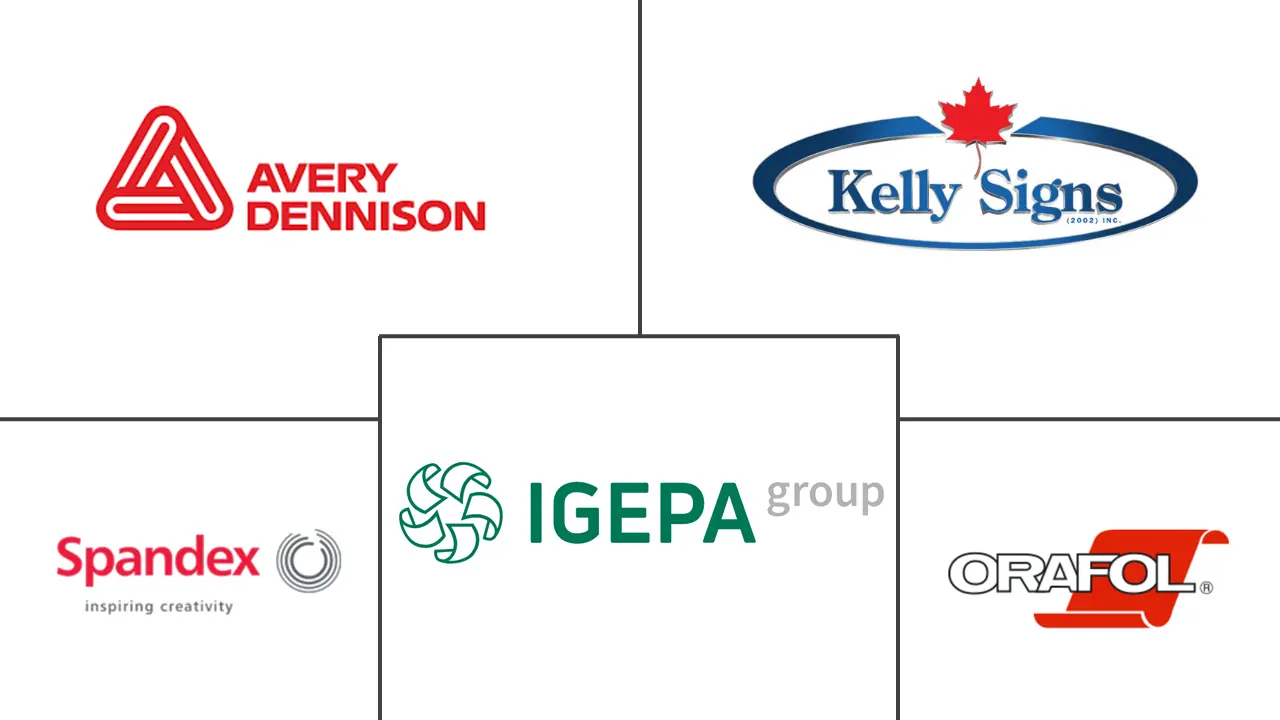
*Disclaimer: Major Players sorted in no particular order |
Need a report that reflects how COVID-19 has impacted this market and its growth?
Printed Signage Market Analysis
The Printed Signage Market size is estimated at USD 41.88 billion in 2024, and is expected to reach USD 45.26 billion by 2029, growing at a CAGR of 1.56% during the forecast period (2024-2029).
Printed signage is one of the most widely used signage solutions worldwide. It is mainly employed to market and advertise products to attract consumers and expand their knowledge regarding availability and features through billboards and backlit displays. Historically, printed signage has successfully engaged a customer, fulfilling the need to grab attention, which is the key to creating awareness within the few seconds a vendor has before the customer moves on from their stores.
Cost-effectiveness is the primary factor that drives market growth, as it offers low-cost and efficient signage solutions for many industries. The low investments required for deploying these signs and their longer lifespan are significant factors in helping the printed signage market survive with intense competition from emerging digital signage. The prime reason behind most businesses and companies that opted for printed signage solutions is the ease of deployment without additional maintenance costs.
The market is also witnessing multiple acquisition activities. For instance, Strategic Factory, a UD-based, single-point provider for print, signage, branded products, and marketing, announced that Baltimore sign manufacturer A|A Signs, which offers signage for commercial real estate developers and several businesses throughout the region, would be joining the Strategic Factory organization. A|A Signs products include building signage, pylon signs, monument signs, vehicle graphics, fleet branding, impact logos, wayfinding, and directional signs.
Large-format printing creates high-impact visuals, such as banners, posters, signs, charts, announcements, diagrams, and marketing displays. Printed signage is used by many companies and organizations for day-to-day operations, significantly for advertising and marketing purposes, commonly across retail locations, lobbies, tradeshows, showrooms, event venues, and purchase points.
Digital signage may incur more significant expenses initially than printed materials but will present long-term savings. This factor is poised to provide significant competition to printed signage. Further, digital signboards' longer lifespan and high resale value influence the adoption of these systems.
Moreover, the pandemic outbreak resulted in a drastic reduction in travel worldwide. This considerably negatively impacted the transportation and logistics industry, restricting outdoor printed signage usage. Also, the printed signage market has several effects due to changing demand from various end-user industries. Printed billboards have declined significantly in most end-user sectors. However, end users, such as healthcare, witnessed an increased need to make signages related to COVID-19 precautions.
Growing demand from developing countries is also anticipated to create growth opportunities for the market. For example, India has a large and rugged terrain. While its book publishing and the commercial printing industry have recovered and are increasingly embracing digital print, the Indian newspaper industry continues to regain its credibility and circulation. The signage industry is also recovering, and new technologies and audiences, such as digital 3D additive printing, digital textiles, and industrial printing, are coming onto the pages.
Printed Signage Market Trends
The Retail Sector Expected to Grow at a Significant Rate
- Retail signage can include anything from posters, banners, and backdrops to pop-up displays and graphics. Signage has always been critical in instantly communicating messages to viewers, creating an atmosphere and emotion that delivers on a brand promise and signposts key organizational messages.
- With the retail industry focusing on expanding and investing considerably in advertising and marketing, the printed signage market is expected to grow further. The retail sector is growing exponentially, aided by the development of e-commerce; however, the brick-and-mortar industry still commands a significant market share, but the growth of e-commerce is comparatively fast-paced.
- Printed signage for retail stores varies in form and size based on location and intention. Still, the primary motive for all, whether an expansive banner or a billboard, is to drive foot traffic and communicate with potential customers. These are placed on the storefront, banners, barricades, and every place of the retail store, and hence are a vital part of the retail business.
- Retail vendors, including brick-and-mortar and e-commerce vendors, are increasingly spending on advertising. This is expected to command a significant share of the printed signage spending. There are various types of retail signage, such as exterior retail signage and interior retail signage. Interior retail signage is focused on getting a customer to make a purchase, primarily to direct customers to specific locations in the store for sales, high-volume items, dressing rooms, or even restrooms. Exterior retail signage is considered an essential kind of retail signage to create an engaging, up-to-date, and fresh invitation.
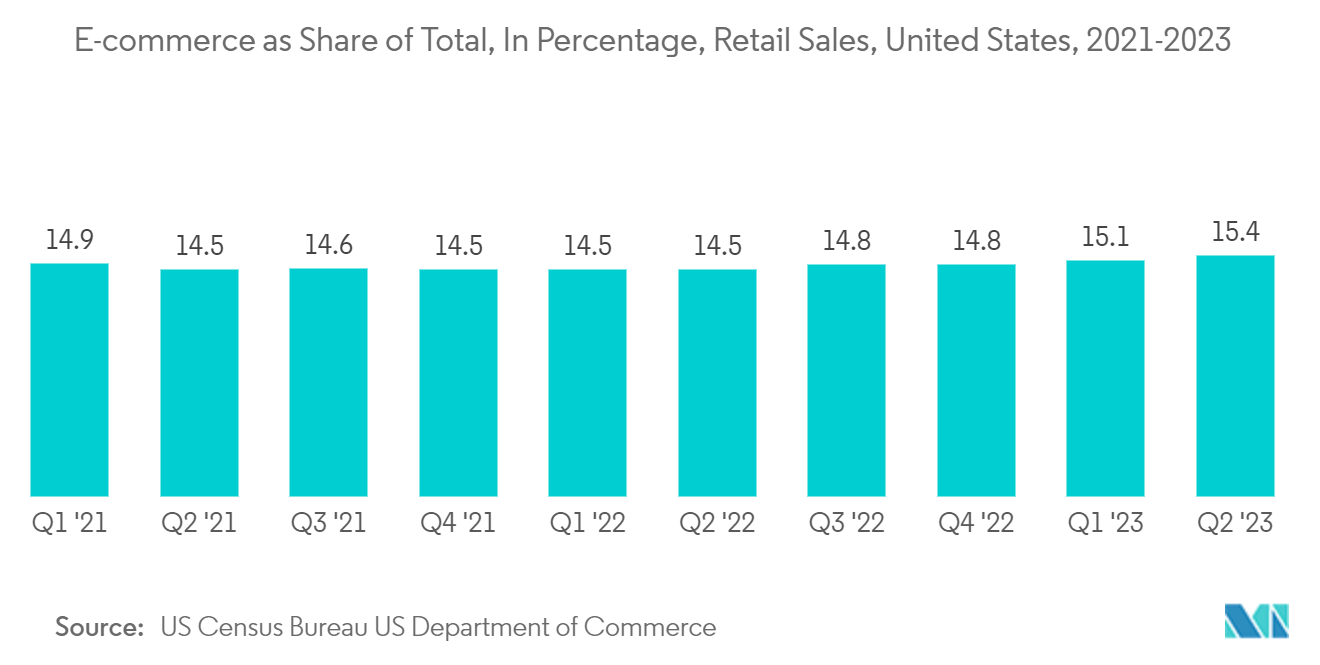
Asia-Pacific to Hold Significant Market Share
- Asia-Pacific is witnessing innovations that broaden the selection of signage printers with advanced and sophisticated designs for businesses. Printed signage is becoming a more popular medium for more people in China due to the country's increasing urbanization. The sector has emerged as the channel that enables companies to consistently and quickly reach a large audience in China as people spend more and more time outside their homes and workplaces.
- Further road signs and spray-painted posts were China's two primary forms of signage advertising. As targeting technology advances, brands can reach their target Chinese demographic more engagingly and contextually with appropriate messaging.
- The top advertisers in print signage advertising in India include companies in the fintech, e-commerce, OTT, real estate, and hyperlocal services sectors. Automobiles, mobile phones, consumer durables, IPL teams, and tech companies are other businesses keeping a close eye on this space. Other factors driving the sector's growth are increased consolidation among media owners and higher adoption of printed OOH's relatively premium properties.
- From sourcing to manufacturing and end product development, the Indian Sign Industry has adapted fervently to the changing times and demands. Technological developments have played a crucial role in causing this transformation, as well as factors like the growing retail and infrastructure industry, the increasing need for advertising, and a growing number of MNCs in India that further boost the signage industry.
- The number of manufacturing units in the country has shot up, and R&D has taken center stage in most company agendas. Secondly, the government concurs with Indian companies in encouraging domestic manufacturing by providing subsidies and tax rebates.
- Moreover, the pandemic pushed the industry's reset button and sparked investments in technology-driven signage media measurement. Significant technological investments have been made in delivering experiential communication, distinguishing OOH from other media, such as large-format outdoor advertisements.
- Government initiatives drive the printed signage market in various regions, helping businesses connect with customers. For instance, the Brihanmumbai Municipal Corporation (BMC) made it mandatory for shops to use signage boards with regional languages to create an inflow of business opportunities for the signage industry in India. With the Media Expo's return after two years, the financial capital will be the ideal meeting point to identify innovative and cost-effective signage solutions.
- Various regional vendors are increasingly focusing on soft signage applications catering to advertisements. For instance, Softjet Grand, the 3.2-meter-wide printer, is an industrial smooth signage printer that combines digital advantages and has been efficiently optimized to replace PVC-based media. It also quickly prints on recyclable polyester-based fabrics and employs environmentally friendly aqueous inks. Softjet Grand is ideal for various soft signage applications, including banners, displays, wall decorations, signage, parasols, flags, backdrops, and outdoor advertisements.
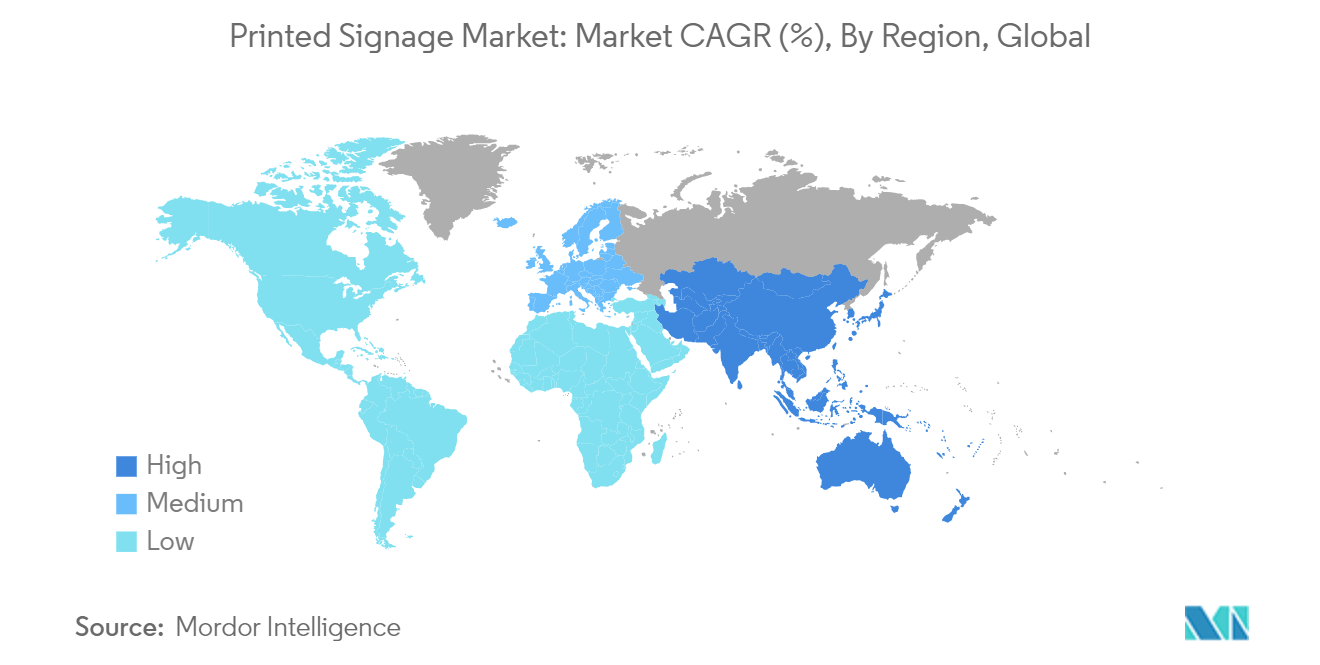
Printed Signage Industry Overview
The printed signage market is highly competitive and consists of several major players. In terms of market share, few players dominate the market. With the rising demand for printing and technological advancement across emerging economies, many companies are increasing their market presence and expanding their business footprint across new markets.
February 2024: Salem One Inc., a leading provider of print-based corporate communication solutions and a portfolio company of Granite Creek Capital Partners, announced its acquisition of iTek Graphics, a prominent printing and graphics company based in Concord, North Carolina. This acquisition was funded by investments from Granite Creek's FlexCap III fund and a co-investment from Patriot Capital. The acquisition is expected to enhance Salem One's current strengths while providing clients with an even more comprehensive range of services.
July 2023: Avery Dennison's TrafficJet Pro continues to lead the digital print revolution by being the most productive traffic sign printing system. Signature Hiller GmbH expands its traffic sign business with Avery Dennison.
Printed Signage Market Leaders
Avery Dennison Corporation
Kelly Signs Inc.
Spandex Ltd.
IGEPA group GmbH & Co. KG
Orafol Europe GmbH
*Disclaimer: Major Players sorted in no particular order
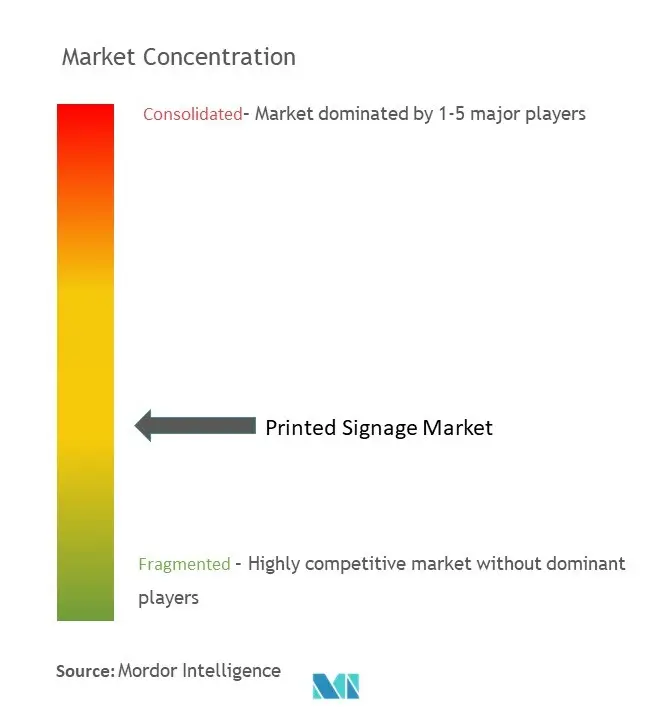
Printed Signage Market News
- February 2024: Kuhn Corp Print & Packaging strategically moved to fortify its position in the sign and display sector by successfully acquiring Regal Signs & Designs from its original owners. This acquisition is in line with Kuhn's commitment to expanding its signage operations and meeting growing customer demand, and it signifies a period of strategic growth for the company.
- December 2023: Panther Premier Print Solutions announced its recent acquisition of Advertising Arts, a company with a long-standing history of 74 years providing custom signage, decals, vehicle graphics, apparel, and promotional solutions.
- July 2023: Brother UK, a business technology solutions provider, launched a first-to-market multifunction printer as resellers move to support businesses wanting to produce high-quality signage and banners. The new MFC-J6959DW device is the first non-specialist, color inkjet printer proposing firms a way to create visuals, from sales banners to promotional signage.
Printed Signage Market Report - Table of Contents
1. INTRODUCTION
1.1 Study Assumptions and Market Definition
1.2 Scope of the Study
2. RESEARCH METHODOLOGY
3. EXECUTIVE SUMMARY
4. MARKET INSIGHTS
4.1 Market Overview
4.2 Industry Value Chain Analysis
4.3 Industry Attractiveness - Porter's Five Forces Analysis
4.3.1 Bargaining Power of Suppliers
4.3.2 Bargaining Power of Buyers
4.3.3 Threat of New Entrants
4.3.4 Threat of Substitute Products
4.3.5 Intensity of Competitive Rivalry
5. MARKET DYNAMICS
5.1 Market Drivers
5.1.1 Cost Effectiveness of Printed Signage
5.1.2 Inclination of the Retail Industry Toward the Application of Printed Signage
5.2 Market Restraints
5.2.1 High Competition from the Digital Signage Segment
6. MARKET SEGMENTATION
6.1 By Type
6.1.1 Banner and Backdrop
6.1.2 Corporate Graphics, Exhibitions, and Trade Shows
6.1.3 Backlit Displays
6.1.4 Pop Display
6.1.5 Billboards
6.2 By Print Technology
6.2.1 Screen
6.2.2 Inkjet
6.2.3 Sheetfed
6.3 By End-user Vertical
6.3.1 BFSI
6.3.2 Retail
6.3.3 Transportation and Logistics
6.3.4 Healthcare
6.4 By Application
6.4.1 Indoor
6.4.2 Outdoor
6.5 By Geography***
6.5.1 North America
6.5.1.1 United States
6.5.1.2 Canada
6.5.2 Europe
6.5.2.1 Germany
6.5.2.2 United Kingdom
6.5.2.3 France
6.5.2.4 Italy
6.5.3 Asia
6.5.3.1 China
6.5.3.2 India
6.5.3.3 Japan
6.5.3.4 South Korea
6.5.3.5 Thailand
6.5.3.6 Australia and New Zealand
6.5.4 Latin America
6.5.4.1 Brazil
6.5.4.2 Mexico
6.5.5 Middle East and Africa
6.5.5.1 United Arab Emirates
6.5.5.2 Saudi Arabia
6.5.5.3 South Africa
7. COMPETITIVE LANDSCAPE
7.1 Company Profiles*
7.1.1 Avery Dennison Corporation
7.1.2 Spandex Ltd
7.1.3 IGEPA group GmbH & Co. KG
7.1.4 Orafol Europe GmbH
7.1.5 Identity Group
7.1.6 Lintec Corporation
7.1.7 3A Composites Holding AG
7.1.8 Signs Express
7.1.9 EhKo Sign Industries KFT
7.1.10 Mactac LLLC (Lintec)
7.1.11 Kelly Signs and Graphics
7.1.12 L&H Sign Company Inc.
8. INVESTMENT ANALYSIS
9. FUTURE OF THE MARKET
Printed Signage Industry Segmentation
Signage printing refers to producing custom signs for various visual purposes. It is an innovative and cost-effective strategy that provides visibility to the business needs. The printed signage market report thoroughly analyzes the primary material, application, and geography.
The printed signage is segmented by type (banner and backdrop, corporate graphics, exhibitions, and trade shows, backlit displays, pop displays, billboards, and other types), print technology (screen, inkjet, sheetfed, and other print technology), end-user vertical (BFSI, retail, transportation and logistics, healthcare, and other end-user vertical), application (indoor and outdoor), and geography (North America [the United States and Canada], Europe [Germany, United Kingdom, France, and Rest of Europe], Asia-Pacific [China, India, Japan, South Korea, Thailand, and Rest of Asia-Pacific], Latin America [Brazil, Mexico, and Rest of Latin America], and Middle East and Africa [United Arab Emirates, Saudi Arabia, South Africa, and Rest of the Middle East and Africa]). The market sizes and forecasts are provided in terms of value (USD) for all the above segments.
| By Type | |
| Banner and Backdrop | |
| Corporate Graphics, Exhibitions, and Trade Shows | |
| Backlit Displays | |
| Pop Display | |
| Billboards |
| By Print Technology | |
| Screen | |
| Inkjet | |
| Sheetfed |
| By End-user Vertical | |
| BFSI | |
| Retail | |
| Transportation and Logistics | |
| Healthcare |
| By Application | |
| Indoor | |
| Outdoor |
| By Geography*** | ||||||||
| ||||||||
| ||||||||
| ||||||||
| ||||||||
|
Printed Signage Market Research FAQs
How big is the Printed Signage Market?
The Printed Signage Market size is expected to reach USD 41.88 billion in 2024 and grow at a CAGR of 1.56% to reach USD 45.26 billion by 2029.
What is the current Printed Signage Market size?
In 2024, the Printed Signage Market size is expected to reach USD 41.88 billion.
Who are the key players in Printed Signage Market?
Avery Dennison Corporation, Kelly Signs Inc., Spandex Ltd., IGEPA group GmbH & Co. KG and Orafol Europe GmbH are the major companies operating in the Printed Signage Market.
Which is the fastest growing region in Printed Signage Market?
Asia Pacific is estimated to grow at the highest CAGR over the forecast period (2024-2029).
Which region has the biggest share in Printed Signage Market?
In 2024, the Asia Pacific accounts for the largest market share in Printed Signage Market.
What years does this Printed Signage Market cover, and what was the market size in 2023?
In 2023, the Printed Signage Market size was estimated at USD 41.23 billion. The report covers the Printed Signage Market historical market size for years: 2019, 2020, 2021, 2022 and 2023. The report also forecasts the Printed Signage Market size for years: 2024, 2025, 2026, 2027, 2028 and 2029.
What are the key drivers of the Printed Signage Market?
Key factors driving the printed Signage Market are a) Low cost of printed signs b) High demand in retail and advertising sectors c) Technological advancements in printing technologies
What are the major challenges faced by the Printed Signage Market?
Major challenges faced by the Printed Signage Market are a) Include the environmental concerns over waste b) Competition from digital alternatives c) Need for high-quality, durable materials
Printed Signage Industry Report
The printed signage market is experiencing robust growth, driven by its cost-effectiveness and ease of deployment, making it a preferred choice over digital alternatives. This growth is particularly notable in retail environments where printed signs are essential for marketing and promotional activities, boosting impulse purchases and enhancing brand visibility. The retail sector's investment in advertising to maintain a competitive edge significantly contributes to this expansion. Furthermore, the signage industry in India is set to expand, fueled by urbanization and the increasing presence of multinational companies. Market segmentation shows a wide application range in both indoor and outdoor settings, with banners, backdrops, and corporate graphics being especially popular. Investments in sheetfed printing technology indicate a strong preference within the industry. Overall, the global printed signage market, supported by traditional marketing strategies and modern retail dynamics, plays a vital role in the advertising and marketing sectors worldwide. For detailed statistics on market share, size, and revenue growth, consult the Mordor Intelligence™ Industry Reports. Get a comprehensive market forecast, historical overview, and more insights by downloading a free report PDF on printed signage analysis.
